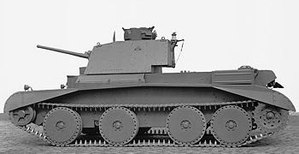Cruiser Mk III
| Tank, Cruiser, Mk III (A13 Mk I) | |
|---|---|
 | |
| Type | Cruiser tank |
| Place of origin | United Kingdom |
| Service history | |
| In service | 1938–1941 |
| Used by | British Army |
| Wars | Second World War |
| Production history | |
| Designer | Morris Commercial Cars[1] |
| Designed | 1936/1937 |
| Manufacturer | Nuffield Mechanisations & Aero, Limited |
| Produced | 1938–1939 |
| No. built | 65 |
| Specifications | |
| Mass | 14 Long tons (14.2 tonnes) |
| Length | 19 ft 8 in (6.0 m)[2] |
| Width | 8 ft 4 in (2.54 m)[1] |
| Height | 8 ft 6 in (2.59 m)[1] |
| Crew | 4 (commander, gunner, loader, driver) |
| Armour | 6–14 mm |
Main armament | QF 2-pounder gun 87 rounds |
Secondary armament | .303 Vickers machine gun 3,750 rounds |
| Engine | Nuffield Liberty V12 petrol 340 hp (250 kW) |
| Suspension | Christie |
Operational range | 90 mi (140 km)[1] |
| Maximum speed | 30 mph (48 km/h)[1] |
The Tank, Cruiser, Mk III, also known by its General Staff specification number A13 Mark I, was a British cruiser tank of the Second World War. It was the first British cruiser tank to use the Christie suspension system, which gave higher speeds and better cross-country performance; previous models of cruiser tanks had used triple wheeled bogie suspension.
Design and development
British cruiser tank design began with the Mk I and somewhat heavier Mk II in the mid-1930s. Just as prototypes were arriving in 1936, General Giffard LeQuesne Martel, a pioneer in tank design who had published works on armoured warfare and pioneered the lightly armoured "tankette" to enhance infantry mobility, became Assistant Director of Mechanization at the War Office.[3]
Later that year, Martel witnessed demonstrations of Soviet tank designs, including the BT tank, which had been influenced by American J. Walter Christie's work. Martel urged the adoption of the Christie suspension and Christie's practice of using a lightweight aircraft engine, such as the Liberty Engine. The government authorized the purchase and licensing of a Christie design via the Nuffield Organization, rather than contact the Soviet authorities.[4][5]
The vehicle obtained from Christie became the basis of the Cruiser Mk III (A13). It had to be extensively redesigned by Morris Commercial Cars as it was too small and had several faults that Christie had not addressed.[1][6] A new company Nuffield Mechanization & Aero Limited was formed for the development and production of the design.[7]
At a meeting of the General Staff, an official specification was determined, which included 30 mm (1.2 in) armour, a 2-pounder gun and a road speed of 30 miles per hour (48 km/h). A subsequent review of the specification by Martel and Percy Hobart approved 30 mm armour all round provided cross-country speed could be kept at 25 miles per hour (40 km/h). Pending the delivery of the A13, an interim design was approved from the A7, A9 and A10, the A9 being selected.[8] Orders for the resulting Mk. I's were limited pending the arrival of the A13.[7]
The first prototype (A13-E1) was delivered in 1937. Following the testing of two prototypes, the A13 was ordered into production. The original order was for 50 tanks and 65 had been built by mid 1939.[5] The Mk III weighed 14 long tons (14 t), had a crew of four, a 340 horsepower (250 kW) engine and a top speed of 30 miles per hour (48 km/h) and was armed with a 2 pounder gun and a machine-gun. When it was introduced into service in 1937, the army still lacked a formal tank division.[9]
Combat history
Like most British cruisers, the A13 was fast but under-armoured and mechanically unreliable. As part of the British Expeditionary Force sent to France, the Cruiser Mark III equipped units in the 1st Armoured Division but most were lost. A few were used in Greece and in the Western Desert 1940–1941 (Libya), where they equipped units of the 7th Armoured Division.[2] The design was used as the basis for the Cruiser Mk IV.[7]
See also

Notes
- ^ a b c d e f White, p. 45.
- ^ a b Great Britain's Cruiser Mk III, A13
- ^ Milsom
- ^ Milsom p. 5
- ^ a b Tucker, Spencer (2004). Tanks: An Illustrated History of Their Impact. ABC-CLIO. pp. 49–51. ISBN 1-57607-995-3.
- ^ Milsom, p. 7
- ^ a b c Doherty, Richard. (2013). British Armoured Divisions and their Commanders, 1939–1945. Pen and Sword. ISBN 1848848382, pp. 11–12.
- ^ Milsom
- ^ Steele, Brett D. (2005). Military Re-engineering Between the World Wars. RAND. p. 14. ISBN 0-8330-3721-8.
References
- Milsom, John; Sandars, John; Scarborough, Gerald (1976). Crusader. Classic Armoured Fighting Vehicles: Their History and How to Model Them. Cambridge: Patrick Stephens in association with Airfix. ISBN 0-85059-194-5.
- Bingham, James (1971). Crusader–Cruiser Mark VI. AFV Profiles. Windsor: Profile Publications. OCLC 54349416.
- White, B. T. (1963). British Tanks 1915–1945. London: Ian Allen. OCLC 30214464.
